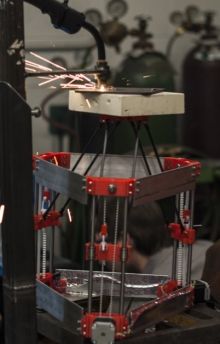Scientists build a $1,500 open-source 3D metal printer

Until now, 3D printing has been a polymer affair, with most people in the maker community using the machines to make all manner of plastic consumer goods, from tent stakes to chess sets. The lack of an open-source metal alternative and the high capital costs and slow throughput of proprietary commercialized metal 3-D printers has severely restricted their deployment.
A team at Michigan Technological University is developing a new open-source, low-cost metal 3D printer that will allow anyone to make his or her own replacement parts or tools in any garage. Led by Joshua Pearce, an Associate Professor of Materials Science and Engineering, the team built a 3D metal printer that can lay down thin layers of steel to form complex geometric objects. It is controlled with an open-source micro-controller and is a combination of a low-cost commercial gas-metal arc welder and a derivative of the Rostock, a deltabot RepRap.
The detailed plans, software and firmware are all freely available and open-source, meaning anyone can use them to make their own metal 3D printer.
The total material cost is under $1,500. But Pearce admit that his new printer is a work in progress. So far, the products he and his team have produced are no more intricate than a sprocket. But that's because the technology is so raw.
"Similar to the incredible churn in innovation witnessed with open-sourcing of the first RepRap plastic 3D printers, I anticipate rapid progress when the maker community gets their hands on it," says Pearce. "Within a month, somebody will make one that's better than ours, I guarantee it."
However, because of safety concerns, Pearce suggests that for now it would be better off in the hands of a shop, garage or skilled DIYer, since it requires more safety gear and fire protection equipment than the typical plastic 3D printer.
Pearce was also concerned about the potential for homemade firearms that some people have already made guns with both commercial metal and plastic 3D printers. But he believes that the good to come from all types of distributed manufacturing with 3D printing will far outweigh the dangers.

In particular, expanded 3D printing would benefit people in the developing world, who have limited access to manufactured goods, Pearce said. "Small and medium-sized enterprises would be able to build parts and equipment quickly and easily using downloadable, free and open-source designs, which could revolutionize the economy for the benefit of the many."
"I really don't know if we are mature enough to handle it," he added cautiously, "but I think that with open-source approach, we are within reach of a Star Trek-like, post-scarcity society, in which 'replicators' can create a vast array of objects on demand, resulting in wealth for everyone at very little cost. Pretty soon, we'll be able to make almost anything."







